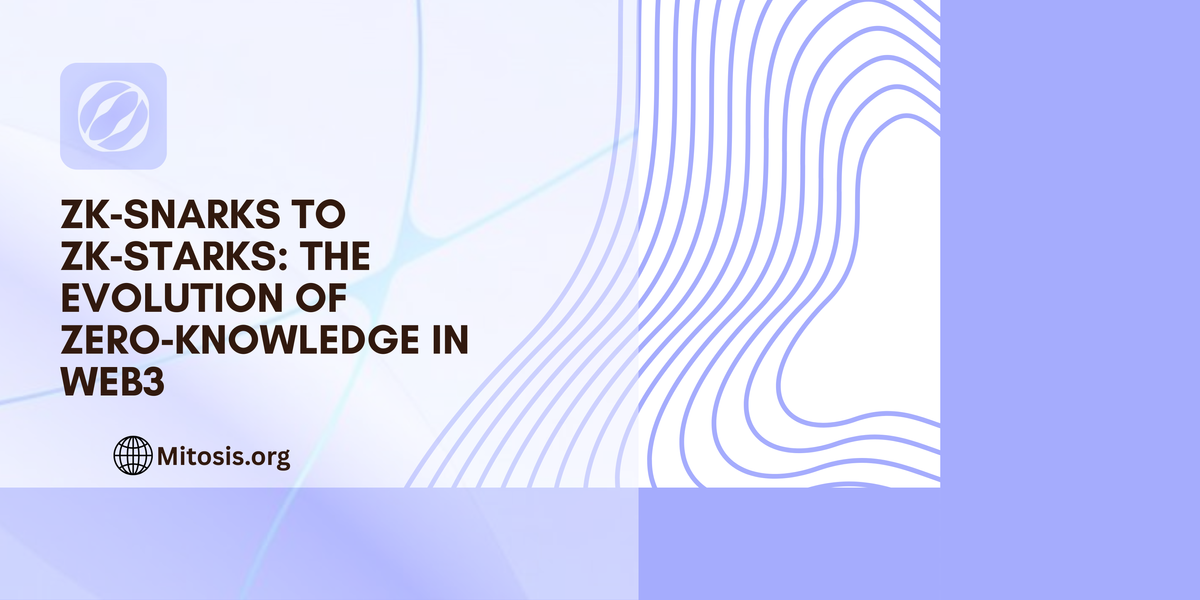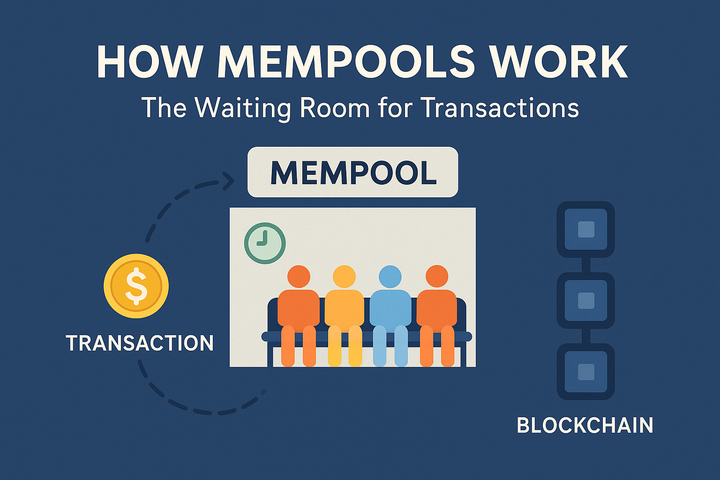zk‑SNARKs to zk‑STARKs: The Evolution of Zero‑Knowledge in Web3

Zero-knowledge proofs (ZKPs) empower parties to verify statements without revealing underlying data, transforming privacy and scalability in blockchain and beyond. See Medium. Foundational mathematics—group theory, elliptic curves, and polynomial commitments—underpins ZK systems, enabling succinct and secure proofs. See Medium. The emergence of non‑interactive protocols like zk‑SNARKs and zk‑STARKs offers distinct trade‑offs in proof size, computation, and trust assumptions, as detailed in comparative analyses. Cutting‑edge implementations, such as Cairo‑EVM by Kakarot, demonstrate practical zero‑knowledge execution on Ethereum, achieving bytecode equivalence with high performance. In DeFi, platforms like Mitosis leverage ZKPs to secure cross‑chain Matrix Vaults and automate governance through Ecosystem‑Owned Liquidity, illustrating how ZKPs enhance both security and composability in programmable liquidity networks.
The Essence of Zero‑Knowledge Proofs
Zero‑knowledge proofs allow a prover to convince a verifier that a statement is true without revealing any additional information. First formalized by Goldwasser, Micali, and Rackoff in 1985, ZKPs consist of interactive and non‑interactive variants, each balancing interactivity and setup requirements. See Medium. The core properties—completeness, soundness, and zero‑knowledge—ensure that honest provers succeed, false statements are rejected, and no extra knowledge leaks to the verifier.
Foundational Mathematics: Groups, Fields, and Elliptic Curves
Understanding ZKPs demands a solid grasp of algebraic structures. Group theory provides the framework for discrete logarithm problems, while finite fields underpin polynomial commitments used in SNARKs. See Medium. Elliptic curve cryptography secures succinct cryptographic permutations like Pedersen commitments and Bulletproofs. See Medium. Mastery of these topics is essential for constructing and analyzing proof systems at the heart of blockchain privacy.
Interactive vs. Non‑Interactive Proofs
Interactive proofs require multiple rounds of communication, as seen in classical protocols like Blum’s coin-flipping or the Schnorr identification scheme Medium. In contrast, non-interactive proofs (NIZKs) like zk‑SNARKs rely on a trusted setup to generate common reference strings, reducing communication to a single proof transmission. zk‑STARKs eliminate the need for a trusted setup by leveraging transparent randomness and polynomial IOPs, trading larger proof sizes for trust minimization.
zk‑SNARKs: Succinct and Efficient
zk‑SNARKs (Succinct Non‑interactive ARguments of Knowledge) provide proofs of constant size (often under 300 bytes) and fast verification, making them ideal for on‑chain verification. Proof generation can be computationally intensive, but advances in compiling circuits and using specialized provers like Groth16 optimize performance. Their reliance on a trusted ceremony remains a key consideration for deployments. See https://medium.com/%40goharhovhannisyann/math-foundations-for-zero-knowledge-proofs-groups-and-their-importance-827d9a858c14?
zk‑STARKs: Transparent and Scalable
zk‑STARKs (Scalable Transparent ARguments of Knowledge) remove trusted setups by employing publicly verifiable randomness and hashing-based commitments. While proof sizes (tens to hundreds of kilobytes) and prover times can be larger than SNARKs, STARKs excel in quantum resistance and auditability. This makes them attractive for high‑security use cases and large‑scale rollups. See https://medium.com/%40goharhovhannisyann/math-foundations-for-zero-knowledge-proofs-groups-and-their-importance-827d9a858c14?
Comparative Analysis: SNARKs vs. STARKs
| Characteristic | zk‑SNARKs | zk‑STARKs |
|---|---|---|
| Proof Size | ~300 bytes | 45 KB–200 KB |
| Verification Time | 1–10 ms | 10–100 ms |
| Prover Time | Variable (optimized by Groth et al.) | Linear growth, hardware‑optimized |
| Trust Setup | Required | Not required |
| Transparency | Trusted ceremony | Public randomness |
| Quantum Security | Vulnerable | Resistant |
| Use Cases | On‑chain privacy, scalable rollups | Data availability proofs, compliance |
See https://medium.com/kakarot-zkevm?
Cairo‑EVM: Ethereum’s First ZK‑Native Client
Cairo‑EVM, developed by Kakarot, is a zk‑native execution client that runs Ethereum bytecode within CairoVM, utilizing StarkWare’s STWO prover for fast proof generation. See Medium. Achieving 100 % bytecode equivalence and eight out of nine EVM precompiles, Cairo‑EVM enables existing Solidity dApps to operate under zero‑knowledge guarantees without code changes.
Real‑Time Proofs and Performance Benchmarks
Benchmarks from StarkWare demonstrate that STWO can reduce proof times by up to 100× compared to earlier provers, enabling near real‑time transaction validation Medium. Combining CairoVM’s arithmetic-optimized execution with parallelized STWO yields sub‑second proof generation for typical Ethereum blocks, making zk rollups more practical for high‑throughput DeFi applications.
Privacy‑Preserving Transactions
Protocols like Tornado Cash pioneered ZKP mixers on Ethereum, hiding transaction graph links via zk‑SNARKs . Newer solutions (e.g., Privatus) incorporate on‑chain mixers with layered anonymity and compliance reporting, allowing regulators to audit suspicious activity while preserving user privacy Medium.
Cross‑Chain Interoperability and ZKPs
Zero‑knowledge proofs underpin secure cross‑chain communication by validating messages without exposing sensitive state data. Protocols such as LayerZero leverage ZKPs for verifying oracle signatures and proof correctness across heterogeneous networks. See Medium. This enhances composability and liquidity flow across rollups and L1s.
Mitosis: Programmable Liquidity Secured by ZKPs
Mitosis integrates ZKPs into its Matrix Vaults framework, issuing miAsset tokens that represent vault shares and automatically verifying yield calculations via zero‑knowledge circuits. Its Ecosystem‑Owned Liquidity (EOL) governance uses ZK‑audited voting to ensure transparent allocation decisions, preventing Sybil attacks through identity‑bound proofs. See https://mitosis.org/
ZKPs in Decentralized Identity
Zero‑knowledge proofs enable self‑sovereign identity by allowing users to prove attributes (age, residency, credential possession) without disclosing raw data. Projects like zkID employ ZKPs combined with SSI frameworks to secure identity verification on‑chain, enhancing privacy and reducing centralized KYC risks .
Developer Tooling and Open‑Source Stacks
Open‑source stacks—such as Halo2, Plonky2, and zkSync’s ZK‑Git—provide modular building blocks for custom proof systems. Frameworks like Noir and Circom simplify circuit definition, while proving backends (e.g., snarkjs, ria) handle proof generation, fostering rapid prototyping of ZKP applications. See Medium.
Emerging Directions: ZKVMs and SP1 zkVM
Efforts like Succinct SP1 zkVM aim to generalize zero‑knowledge execution for smart contracts, offering Rust‑native proof generation with minimal changes to existing codebases. Meanwhile, zkEVM standards are converging on byte‑level compatibility, bridging EVM semantics and zero‑knowledge verifiability.
15. Conclusion
Zero‑knowledge proofs stand at the nexus of privacy, scalability, and interoperability in blockchain. Continued advancements in proving systems, transparent setups, and developer tooling will drive mass adoption. Integrations by platforms like Mitosis illustrate how ZKPs not only secure programmable liquidity but also enable novel governance and identity models, charting a course toward a more private, efficient, and interconnected Web3 ecosystem.
🔗Links:



Comments ()